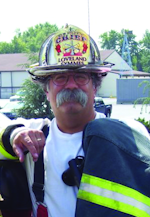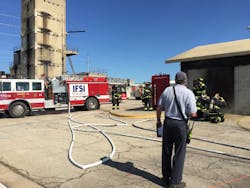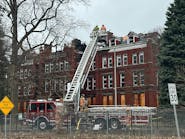Close Calls: New Year, New Lessons: 8 Critical Fireground Factors
While we have covered it many times before, it’s worth stating again: The best way for us to honor a fallen firefighter is to learn the facts about what happened, and then share what we learned about the incident at our local fire departments and with our mutual-aid partners so such a tragic event doesn’t happen again.
This month I wanted to take a little different approach to the column and provide a simple list to help you consider some of the key factors in avoiding a firefighter close call, line-of-duty injury (LODI) or line-of-duty death (LODD). This information is based on actual LODIs and LODDs that are well documented. Much of what you will read below is about personal, personnel as well as organizational preparedness along with no-BS command, control, discipline and accountability on the fireground. I also added a few “personal notes” following each section, many based upon my own experience and first-person observations.
Before we delve into the list, I want to first emphasize the importance of all departments having written, relevant and accessible policy and procedures related to fireground operations. To ensure that we are all speaking the same language, policy is what is expected to be done, and procedure is what action and resources are required to get that stuff done.
1. Learn about fire behavior for yourself
As we have recently learned through NIOSH, UL, IFSI and other related organizations’ studies—not to mention what we observe at actual fires—fire may not behave in the same manner that we thought it would. It’s important to take what you know and then learn from the new data being presented by fire service researchers. Notice I didn't say to “throw out all you know” or any silly stuff like that, because what you know from experience is yours to keep and use. There is no need to necessarily change per se, but more so to evolve to make sure that you are the best at what you are expected to do and have the best information possible. And this applies no matter WHAT your rank. Fires, building construction and fire behavior has evolved—and so must we.
Personal note: For years, we would get to fires and be told to open up, open up and open up. And for years, at many of these fires, when we did just that, suddenly fires got much worse, and it always happened after we opened. “Well damn, this fire must have been arson!” Not exactly. In reality, we simply didn’t understand the benefits or consequences of our actions on the fireground. We didn’t understand the science of fire behavior. Of course, back then, it wasn’t really a failure; we just didn't know any better. Today we do, and factual, proven, expert information is available immediately to all of us. Take time to learn the latest about fire behavior and add that to what you already know.
2. Conducting a size-up
Ensure that a 360-degree size-up is conducted whenever possible at every fire and incident—and it can’t be different based upon who is working that day, who responded to the call or who likes doing it or doesn’t like doing it. Consideration must be given to conditions, such as occupied or unoccupied structure, fire location/related conditions, building contents, construction features, weather and resources available. A tactical plan must be developed, communicated and implemented in an organized and disciplined manner for each fire by the first-arriving officer. Further, even after the initial assessment is conducted, a continuous risk assessment should be performed throughout the incident, and the strategy and tactics must be continuously adjusted to match the conditions. Get on the proper channel and state who you are, what size the structure is, what you see, what actions/strategy you want taken, where the water is coming from, who is in command, and where command/accountability is located. It’s not all that difficult to do, but it is critical in setting the foundation for fire scene “life support” for the victims and firefighters alike.
Personal note: You might be thinking, “Size-up? It’s a house on fire, we need to just deal with that.” Yeah, but a size-up is part of effectively dealing with incidents in 2018 firefighting. We still see departments failing to perform and communicate a uniform size-up that must include the plan and expectations from whoever just gave the size-up. Not long ago, we would arrive and state, “Engine 1 is on the scene,” and that would be it, and crews would BEG for more info … and ultimately have to guess. What works better? Try this: “Engine 1 is on the scene, we have a medium-size single-family dwelling with smoke and fire out of the second floor, side alpha, companies shall operate in an offensive mode, hydrants are located on the block, Engine 1 has Maple Avenue command.” That way, EVERYONE coming to your fire is speaking the same tactical language. Figure out a system and agree that everyone will use it.
3. When, how and why to perform ventilation
Unfortunately, we still find that venting is not well understood, as the fire doesn’t always get better when we “open that building the hell up!” Ventilation must be coordinated with tactical activities, including search, rescue and our favorite … getting water on the fire. Without over-simplifying it, ventilation is not an independent act conducted by those who like to vent. It must be done (or not done) intentionally based upon Command’s plan.
Personal note: Not venting can also be a problem, however, freelance venting can and has led to extremely unfortunate outcomes on the fireground. Don’t open anything unless that is what Command wants or expects to be done. Get used to making sure that Command knows what is happening on their fireground because Command wants THAT to happen.
4. Getting water on the fire
Can you ensure that your interior attack crews always enter the immediately dangerous to life and health (IDLH) fire environment with a charged hoseline? Can cops ensure that when they enter a bank robbery environment that their guns have bullets? The answer to both oughta be yes. Can you ensure that your crews know their best options in getting water on the fire based upon resources as quickly as possible? Do your folks consider what they would want done if it were their house on fire? Is your fire apparatus set up to actually fight a fire or is that an afterthought and perhaps crews need a 14-foot roof ladder to reach the handlines on the rig?
Let’s make this easy: Go on the Internet and select some fire videos from a big city, small city, rural area or whatever reflects your first-due—or perhaps even watch your own—and determine how fast your crews can establish a water source and stretch lines to get water on the fire or at least between any trapped victims and fire? While it seems simple, we still see apparatus set up where it appears the LAST thing they want to do is quickly deploy a line. We see companies struggle with getting their first line on the fire—and that's a huge factor in determining how the rest of that fire will go … and who goes home.
Personal note: I recently observed a small suburban fire department (three stations) and a larger urban fire department (30 stations) dealing with a two separate multi-family dwelling fires, each with many similarities (i.e., occupancy, construction type, fire and black high-velocity pushing smoke showing). While the suburban department chose to hit the main body of fire with a deck gun on arrival (water flowing in less than 45 seconds with tank water and hydrant connected, along with two handlines for maneuverability), the larger department took nearly 15 minutes to darken its fire. The one thing that really stood out was that the smaller department was more open to understanding what could be done quickly to knock down the fire where the larger department seemed very narrowly focused on just one way to attack the fire—and they ran out of structure before they could knock it.
5. Rapid-intervention crews/teams
Can you assure your members that a qualified/well-trained and adequately staffed rapid-intervention crew (RIC) will be on the scene pretty much whenever they may be needed? While naturally there will be that occasion when a firefighter rescue crew is delayed, your department needs a policy that clearly dictates when that team will be dispatched.
The best solution to ensure that they are there is that they be dispatched at the same exact time as a first-alarm assignment. If you provide your own team, that’s great, as long as you have the other 20 or so firefighters minimally required for even the smallest dwelling fire. If not, or in the case of volunteer departments with known low turnouts, then who is on your team? While it is no secret that, generally, unstaffed volunteer departments are struggling from coast to coast, there hasn’t been a more critical time to pool resources and send several companies or departments on the first alarm, including a firefighter rescue team. There are few chiefs who DON’T know who is responding based upon the time of day, and in so many cases, few are turning out. Take the time now to allow your department to evolve along with the community and society as a whole. Nope, I don’t like it ether, but this job is hardly about what you like.
Personal note: Just a few years ago, there was a fire where a firefighter became trapped. As the facts of the fire eventually came out, it was discovered that the initial company of firefighters assigned to rapid intervention didn’t want to do that job—so they freelanced. They ignored their orders. So that I am really clear here: They didn’t WANT to do rapid intervention; they wanted to go interior, so they did. They made the fire scene their personal playground, as opposed to doing as ordered (and needed) on this mutual-aid fire scene. While freedom is a civilian right in North America, it is not a firefighter right on the fireground.
6. LOVE your apparatus, tools and equipment
How do you know that the rig and the tools are ready for immediate use? How did Firehouse Magazine 2016 Michael O. McNamee Award of Valor winner, FDNY Firefighter James Lee, KNOW his lifesaving rope could be counted on to lower himself and the victim? Equipment checks. No-nonsense, never-ignored, surgically precise equipment checks, as always, conducted in the same manner that you would want conducted if your life depended on them. Simply put, develop your policy (which should include what the manufacturers suggest or require) and then the procedure of who, what, when and why—and then ensure that everyone is fully trained to handle these checks.
Personal note: Years ago, I turned out for a working dwelling fire. When I arrived, I walked around back to where the first engine had stretched, and to my amazement, the first-due crew was flowing a 1¾-inch handline WITHOUT A NOZZLE. That’s right, there was no nozzle on the line and the crew and officer were trying to make it work. It didn't work.
How can that happen? The shift prior had done some scheduled nozzle maintenance but failed to place a spare nozzle in its place. Several runs came in, they got busy, and it was forgotten when shift change occurred. Fortunately, we had a system in place that required crews to perform truck checks at the start of every shift, which included checking to ensure nozzles were in place. The officer and crew did the paperwork (check, check, check, check—yep, everything is there so let’s go have breakfast) but never actually did the checks. In addition to their blatant falsification of records, the lack of nozzle could have caused them some horrific personal outcomes. Do your truck and equipment checks in the same way that you want your pilots or your surgeon doing theirs.
7. Clear fireground communication
What is your fireground radio usage policy? What are the procedures? Can all of your area mutual-aid departments communicate with one another? Is THE fireground channel(s) recorded? Do you know where there may be “dead” zones, and what is the procedure for those areas? When are you expected to speak on the radio? Some departments now employ a standard that simply states to not talk unless what you are going to say will have an impact on the incident.
Personal note: On the scene of a recent firefighter LODD, several mutual-aid fire departments were operating on “their own” fireground channels once arriving on the scene and had no capability of speaking to one another during the fire—or the mayday.
8. Deployment staffing
There really is no “mystery” in determining what staffing will be needed for an emergency in your fire response area. Simply take any building, figure out the required fire flow, and then apply the staffing needed in order to establish water, stretch and flow the lines and use all the tools to perform the required tasks. It’s not that difficult, yet we continuously see poor staffing as an issue, with dumbfounded looks on people’s faces as to what can be done.
While a community can only fund what they are willing to afford, that community must then understand what level of service they will get—or not get. But it is also required by leadership to consider ALL options in solving the problem, from automatic mutual aid (mutual aid, not one way) to consolidation to changing your deployment model. There are a variety of solutions but few excuses when the tones go off and we “simply don't understand” where all our members are.
Personal note: I recently monitored a working fire in a mid-rise multi-family dwelling. The primary fire department called for lots of help quickly, but the mutual aid was anything but quick. They couldn’t be counted on. For example, one station took 15 minutes to muster a crew (and then respond) for a much-needed piece of apparatus.
Unfortunately, many areas fail to honestly acknowledge that they have a problem and refuse to do what’s needed for those having the emergency. They ignore it and hope it will go away. But it’s NOT going away. Fire departments were formed to help people with a specific problem during a specific time. If your department still staffs and operates like it did 50 years ago, but your community looks nothing like it did 50 years ago, your mission and promise to the community has probably failed, but luck may have been on your side. But how long will this “luck” last?
What stops the actions when a fire department must evolve? There may be a variety of reasons, from societal to genuine fiscal issues to personal interest. Many times those who have the power to make the changes don’t want to change because then they won’t be able to derive some of the benefits that they currently enjoy (i.e., pay, benefits, power, free car).
The general solution is one of “forcing” the organization to look at itself and to grow and evolve through internal or external leadership—as tough as that will be. From using an outside consultant or facilitator to a community-based focus group (the taxpayers who derive the service, the elected officials who fund the service, and those who provide the service—the firefighters) that identifies the challenges, issues and problems, there is definitely light at the end of the tunnel when we focus on what’s best for those needing our help.
Final thoughts
My goal in this month’s column was to give you some “proven to be” important areas to think about as you and your departments start off 2018. Each of the above points was a factor leading to the critical injury or deaths of firefighters in 2017, so I urge you to consider these factors—as well as others that we'll cover in the future—so you can take steps to best prepare your personnel to be able to keep their New Year’s resolutions.

Billy Goldfeder
BILLY GOLDFEDER, EFO, who is a Firehouse contributing editor, has been a firefighter since 1973 and a chief officer since 1982. He is deputy fire chief of the Loveland-Symmes Fire Department in Ohio, which is an ISO Class 1, CPSE and CAAS-accredited department. Goldfeder has served on numerous NFPA and International Association of Fire Chiefs (IAFC) committees. He is on the board of directors of the IAFC Safety, Health and Survival Section and the National Fallen Firefighters Foundation.






